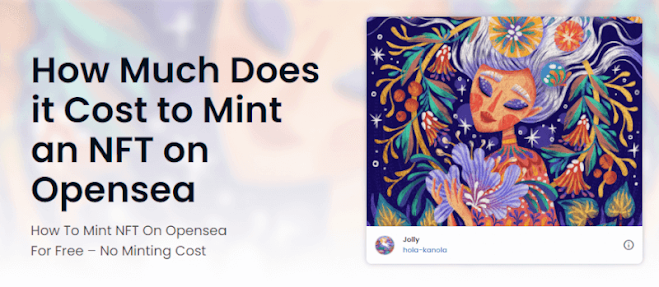How Much Does It Cost To Mint An NFT?

Artists and gamers alike are beginning to see the benefits of NFT trading. Smart contracts give them the power to automate and customize royalties for the secondary market. As blockchain builds up Web3, the internet's tokenized infrastructure, anyone can become a part of this process by creating (minting) an NFT.
Here is the breakdown of the costs and options at your disposal.
What exactly Is NFT minting?
Creating an NFT means adding a smart contract to the network, as another permanent data block to its chain. Just like you add such a block when you make a token transfer, this distributed digital ledger (DLT) records it, making it immutable and unfalsifiable. For this service, a user must pay a gas fee on any blockchain.
An NFT is the same, except it uses an ERC-721 or ERC-1155 smart contract standard instead of the regular ERC-20 for fungible tokens. Any type of digital file is mintable. Moreover, the media file minted by the smart contract as an NFT doesn't necessarily have to be stored on the blockchain.
An NFT can be stored on a software wallet like MetaMask, an offline hardware wallet like Nano Ledger X, which can connect to MetaMask, or on a decentralized storage platform like IPFS (InterPlanetary File System). Case in point, Piñata allows for off-chain, decentralized NFT storage on the back of IPFS.
As for picking the right blockchain network, by far the largest one is Ethereum (ETH), followed by Binance Smart Chain (BNB), Solana (SOL), Fantom (FTM), Avalanche (AVAX), and others.

Although all of them have significantly lower fees for NFT minting than Ethereum, they have a much smaller user base to appreciate NFTs. Which brings us to the topic at hand, how to avoid high minting fees?
Choosing the right NFT marketplace
Fortunately, it is no longer the case that an NFT marketplace is exclusive to the most expensive smart contract platform, such as Ethereum. The largest one, OpenSea at $19.72 billion trading volume, expanded from Ethereum into Polygon and Klaytn. While Polygon (MATIC) is a Layer 2 scaling solution for Ethereum, Klaytn (Klay) is an enterprise-grade blockchain for businesses.
Polygon alone makes a drastic difference in eliminating gas fees needed to mint NFTs, by a factor of 5514x.

OpenSea is also extending its support to Tezos (XZT), another cheap blockchain with negligible gas fees at about 10 cents per transaction.
You can already take advantage of Tezos by going to Rarible NFT marketplace, which already supports Tezos in addition to Flow blockchain, specifically built for NFTs and blockchain gaming. Flow (FLOW) is even cheaper than Tezos, as it charges two fees: 0.001 FLOW for account creation and 0.00001 FLOW for transaction fee.
Presently, one FLOW is $6.57, so we are talking about fractions of a cent. Likewise, Solana (SOL) has its own NFT marketplaces Solanart and Magic Eden, with equally negligible minting costs. For example, Solanart charges 0.00001 SOL on average to mint NFTs, which is presently $0.0000026.
As you can see, circumventing ETH as an NFT currency of choice to pay gas fees gets rid of the NFT minting cost almost completely. However, what if you don't want to bother with alternative tokens, conversions, and networks?
Staying on Ethereum to mint NFTs
Assuming you are not a celebrity who got access to a highly curated NFT marketplace like NiftyGateway or SuperRare, let's focus on OpenSea once again. The largest NFT platform has a simple fee structure:
Not paying for a gas fee upfront is also called lazy minting. Effectively, you are deferring the minting fee after the sale. In the meantime, the NFT you provisionally minted is available off-chain, so not yet on the blockchain. Some platforms, such as CocoNFT, entirely rely on lazy minting for all NFT launches.
However, where it gets complicated is that ETH gas prices vary wildly, depending on the network's congestion. In addition to this, if the buyer pays more for the NFT, the minting will rise proportionally. Therefore, there is no one-figure cost you can count on.
Instead, ETH gas fee has to be calculated manually, depending on the current rate. However, the calculation formula is always the same:
Therefore, if the current average gas fee is 88 gwei, times 21,000, we arrive at 1,848,000 gwei. This is 0.001603 ETH, or $4.34. Because ETH gas goes up and down constantly and wildly, it is then impossible to predict the exact cost.

Keeping this in mind, for setting up an OpenSea account, the ballpark figure is in the $50–$300 range, as a one-time payment. The second transaction is $7–$32. From then on, you can rely on lazy minting, i.e., OpenSea taking a 2.5 percent cut off every finalized sale.
Although this is very inconvenient and confusing, it also bears keeping in mind that Ethereum is in a transitory stage. This year, the network should become fully reliant on a proof-of-stake consensus, as the old proof-of-work docks with Beacon Change. Likewise, the sharding upgrade and other EIPs should deal with gas fee volatility directly via greater scaling and bandwidth.
In the meantime, Ethereum's layer 2 solutions such as Polygon, Arbitrum, Loopring, and Optimism are growing more popular by the day.
Rahul owns no cryptocurrencies.
International Business Times holds no liability for any investments made based on the information provided on this page. We strongly recommend independent research and/or consultation with a qualified professional before making any investment decisions.

© Copyright IBTimes 2022. All rights reserved.

Post a Comment